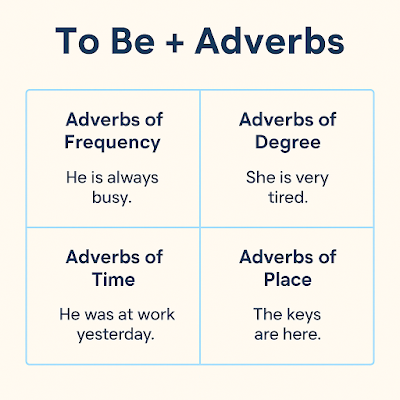📝 How to Use the Verb “To Be” with Adverbs (B1–B2 English)
One of the most common verbs in English is “to be” — and it's also one of the most important! But did you know that using it correctly with adverbs can make your English sound much more natural and accurate?
🔍 What is the Verb “To Be”?
The verb “to be” helps describe states, feelings, identity, time, and location. Its forms include:
-
Present: am, is, are
-
Past: was, were
-
Perfect: has/have been
-
Future: will be
Examples:
-
She is a teacher.
-
They were tired.
-
We have been busy.
🧠 Can You Use Adverbs with “To Be”?
Yes! Many adverbs work with the verb “to be.” These adverbs describe how, when, how often, or to what degree the state happens.
🗂️ Common Types of Adverbs with “To Be”
1. Adverbs of Frequency
Tell how often something happens.
✅ Placement: after the verb “to be”
Examples:
-
He is always late.
-
They are never rude.
-
She was often tired after work.
2. Adverbs of Degree
Describe intensity or extent.
✅ Placement: before the adjective or past participle
Examples:
-
I am completely ready.
-
She is very happy.
-
We were almost finished.
3. Adverbs of Time
Tell when something happens.
✅ Placement: usually at the end of the sentence
Examples:
-
They were at home yesterday.
-
She is at the office now.
4. Adverbs of Place
Tell where something happens.
✅ Placement: often at the end
Examples:
-
The books are here.
-
He was outside.
⚠️ Common Mistakes
❌ He always is late.
✅ He is always late.
❌ She is very much tired.
✅ She is very tired.
❌ They were at the beach often.
✅ They were often at the beach.
✏️ Quick Practice
Try completing these with the correct placement of the adverb:
-
I ___ (always) am happy. → ❌
-
She is ___ (really) excited. → ✅
-
They are ___ (often) in the kitchen. → ✅
✅ Summary: Placement Rules
| Adverb Type | Example | Placement |
|---|---|---|
| Frequency | He is always busy. | After “to be” |
| Degree | She is very tired. | Before adjective/participle |
| Time | He was at work yesterday. | Usually at the end |
| Place | The keys are here. | Usually at the end |
🎯 Final Tip
The verb “to be” is simple — but combining it with the right adverb in the right place can take your English to the next level. Keep practicing and pay attention to patterns when reading or listening to English!





No comments:
Post a Comment